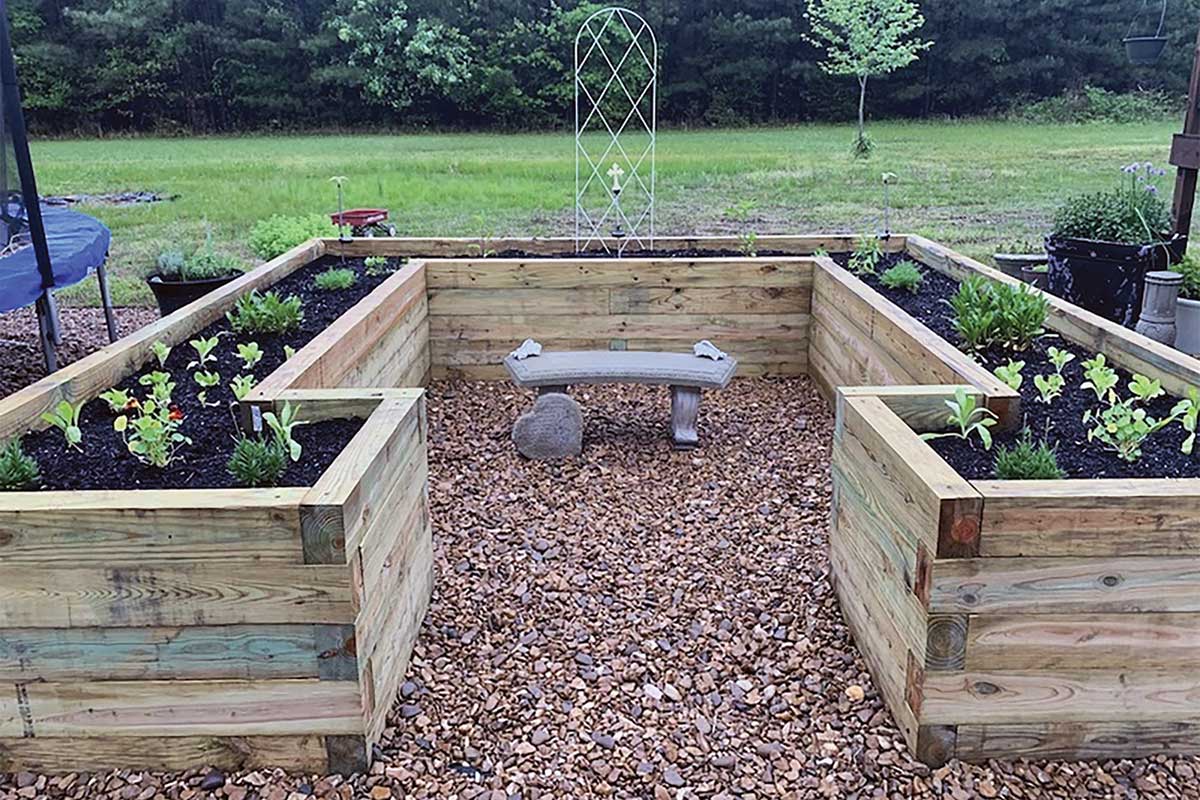Not much good came out of the pandemic, but one thing that can be seen as a positive is the fact that many folks found time to take out their frustrations by working in their yards. Reduced trips to the grocery store allowed people the chance to grow their own vegetables and fruits—and save money while they were at it. People also earned a sense of pride that comes with becoming, at least a bit, self-sustaining.
Raised bed gardening may be for you if you are limited in space and time, or if the physical toll of traditional gardening leaves you with aches and pains. Raised gardens come in a wide variety of sizes, shapes, materials, styles and complexity. They all have pros and cons, but every one of them is easy to manage and will grow just about anything, including small trees.
“For those of us struggling with heavy clay soil, as we do in most of East Texas, raised beds can turn your yard or property into a year-round herb-, veggie-, fruit- and flower-producing bonanza,” said Beth Miller, past president of the San Jacinto County Master Gardeners and a Piney Wood Lakes Texas master naturalist. “All raised gardens begin with a containing structure filled with well-draining soil atop a nutrient-producing mix of compost and composting materials that enrich the soil as they decompose, creating an inviting environment for beneficial bacteria and earthworms that do much of the work for you.”
Garden heights can range from just 6 inches above the ground to as high as you can handle comfortably, generally 18 inches to 3 feet, according to Miller. Large barrels, feeding troughs, untreated wood, metal, concrete, stones, recycled glass bottles, bamboo, and even hay or grain bales all can be used as containers for gardens.
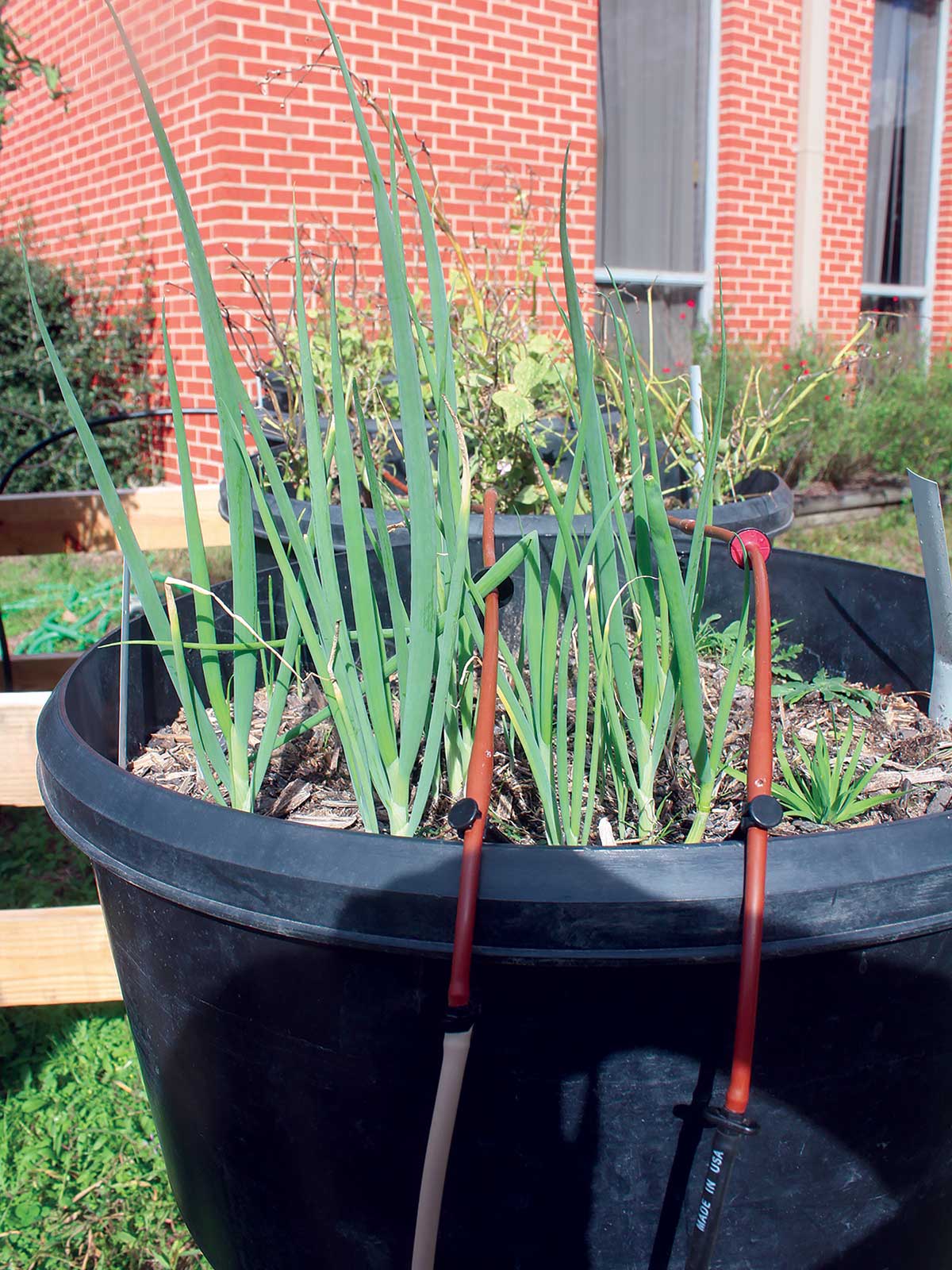
Green onions can grow year-round in a raised tub garden, like this one at the Texas AgriLife Extension office in Livingston.
Jeff Miller
Whether you buy a ready-made garden kit or build your own, you have choices on style, cost and ease of assembly. Cedar is the most popular wood for raised beds because of its durability, rot resistance and lighter weight compared to other woods.
Consider where to place the beds so they’ll get plenty of sun as well as the size needed to hold the full-sized plants you’ll want to grow. Remember to allow easy access from all sides so you can fertilize, trim, and pick and pluck a weed or two.
Keyhole Gardens: Compost in the Garden
A garden innovation from Africa known as keyhole gardening has taken root here in Texas. While excellent in hot and dry locations, a keyhole garden improves growing conditions in just about any climate.
A keyhole garden consists of five layers—soil for planting, compost, grass and leaves, twigs, and thick cardboard at the bottom—and produces most of what plants need to thrive.
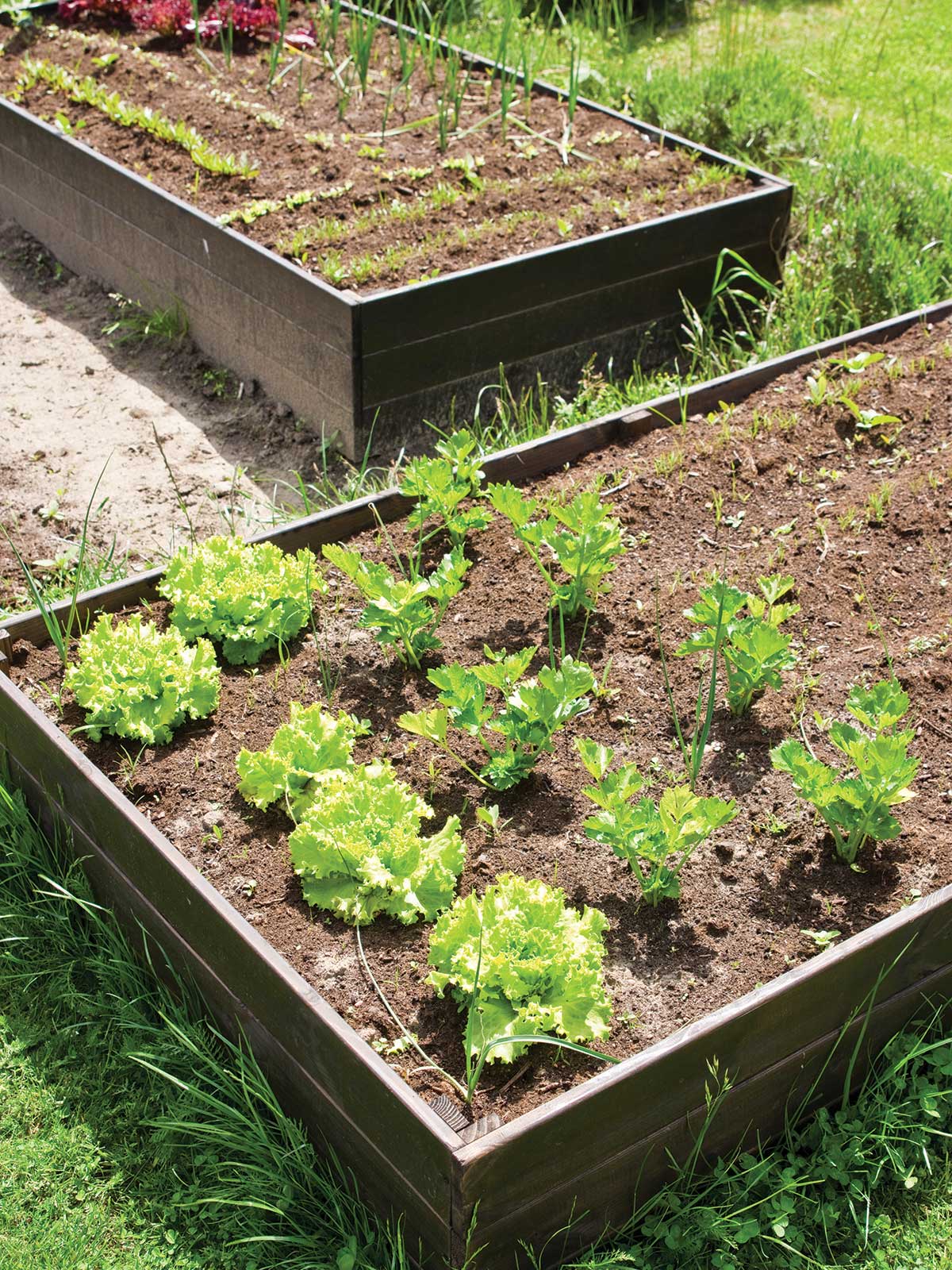
Box gardens are easy and inexpensive to build. Concrete end pieces have slots where wood planks fit and can be as short as 6 inches or as tall as 2 feet. Materials can be found at home improvement stores and can consist of as many pieces as you want.
AHatmaker | iStock.com
From a bird’s-eye view, the garden is shaped like a keyhole. A notch is cut into a round garden bed, allowing for easy access to the center compost well. The notch also allows a gardener to reach the center plants for picking and trimming. This sustainable type of gardening uses kitchen and garden waste along with gray water (or wash water) as food for your garden, stored in a compost well. When it rains or you water the compost, nutrients seep into the surrounding bed. Covering the compost during a rainy period or heavy storm keeps the nutrients in the compost from leaching out too rapidly.
Layering has proven to enhance soil health. In an article in the February 2012 issue of Texas Co-op Power, creative landscape architect Deb Tolman offered layering suggestions: wood on the very bottom, then cardboard, then a bit of compost, followed by petroleum-free newspaper, manure, worms, wood ash, straw and topsoil. Repeat the layers with compost, straw and topsoil, or a similar combination, until you reach the desired height.
You can learn more about keyhole gardens in Texas at debtolman.com.
Straw Bale Gardens
While not always the most aesthetic of raised beds, straw bale gardens use ordinary farmer’s straw as the principal growing medium.
“After conditioning for a few weeks with a small amount of potting soil, compost and fertilizer, all you need is a bale of hay or straw, and you have a minigarden,” Miller said. “The bale can be placed cut-side up on a driveway, in an alley or in among your yard, wherever it will get six to eight hours of sunlight a day.”
Season the bale by watering it daily for 10–14 days and then you’re ready to plant directly into the bale. Adding a bit of nitrogen, like blood meal, can speed the seasoning process. Spread a thin layer of garden soil on top of the bale around transplants to shelter the roots or for planting seeds, then just keep the bale watered and watch it grow.

Straw bales can get heavy when wet, but with proper seasoning, they can serve as a growing medium that provides all the nutrients your plants need.
Debibishop | iStock.com
A straw bale garden can also be portable if placed in a shallow wagon with drainage or on a pallet with wheels so you can drag the garden to wherever the sun is optimal throughout the day.
One important fact to remember, though, is that watered bales can get very heavy, making them much harder to move. Plan your plants for each bale with sun requirements in mind to keep from moving very often. Sun-loving plants include tomatoes, okra, cucumbers and peppers. Shade-loving plants include strawberries, beets, peas and leafy veggies. Mix in some herbs and flowers as companions for your veggies.
Ask your supplier for organic bales or at least request that the hay has not been sprayed with any herbicides. Bales are only about 14 inches wide, 18 inches tall and 40 inches long, so if all you have is a small space, it makes a perfect raised bed.
“As the bales break down, they may need to be staked or supported on the sides beyond the string,” Miller said. “Using tall stakes at either end or on the corners and running twine between the stakes provides support for tall plants and the bale. If you can, leave the remains in place for a fall planting or let it continue to break down until next spring, when you can spread it around your yard.”

Raised gardens don’t have to be big to be bountiful. This raised 2-by-3-foot planter provides enough space for several varieties of lettuce.
Jeff Miller
You can also add it to your existing compost pile if you are not planting a fall garden. Transplant any perennials in your bale to your yard or into pots. Herbs can be dried for use later in fall soups or potpourri.
Getting the Composition Right
Use cardboard, flattened boxes or newspaper in the bottom of your raised garden bed for one very good reason: to keep weeds out. For best results, place a single layer of cardboard or five to six layers of newspaper at the bottom of your bed. Be sure to cover the entire base so no weeds can creep in from the outside. Placing a heavy layer of mulch on top will also help keep the weeds to a minimum.
The great thing about using cardboard or newspaper in your raised bed is that the cellulose in the paper is an organic material, which results in a more fertile soil that’s easier to work with.
Retaining moisture is one common concern for people using raised bed gardens. Unpredictable East Texas weather means a gardener may get too much rain or not enough. Gardeners can solve this problem by mulching with straw. Not only will it keep the soil moist, but it will also help to keep the weeds out.
Gardeners may consider buying soil in bulk or by the cubic foot or cubic yard if they plan to have more than one raised bed. An online soil calculator—such as the one at gardeners.com/how-to/soil-calculator can help you determine the exact amount of soil that you’ll need.
Generally speaking, gardeners should use soil proportioned as 60% topsoil, 30% compost and 10% potting soil. (You want a soilless growing mix that contains perlite, peat moss and/or vermiculite.) These proportions are approximate, as soil volume can vary from source to source.
Peat moss may also be added to raised beds. However, it should not be more than 20% of a total mix. It’s worth noting that peat moss is naturally acidic, which means it is not the best medium for growing vegetables.
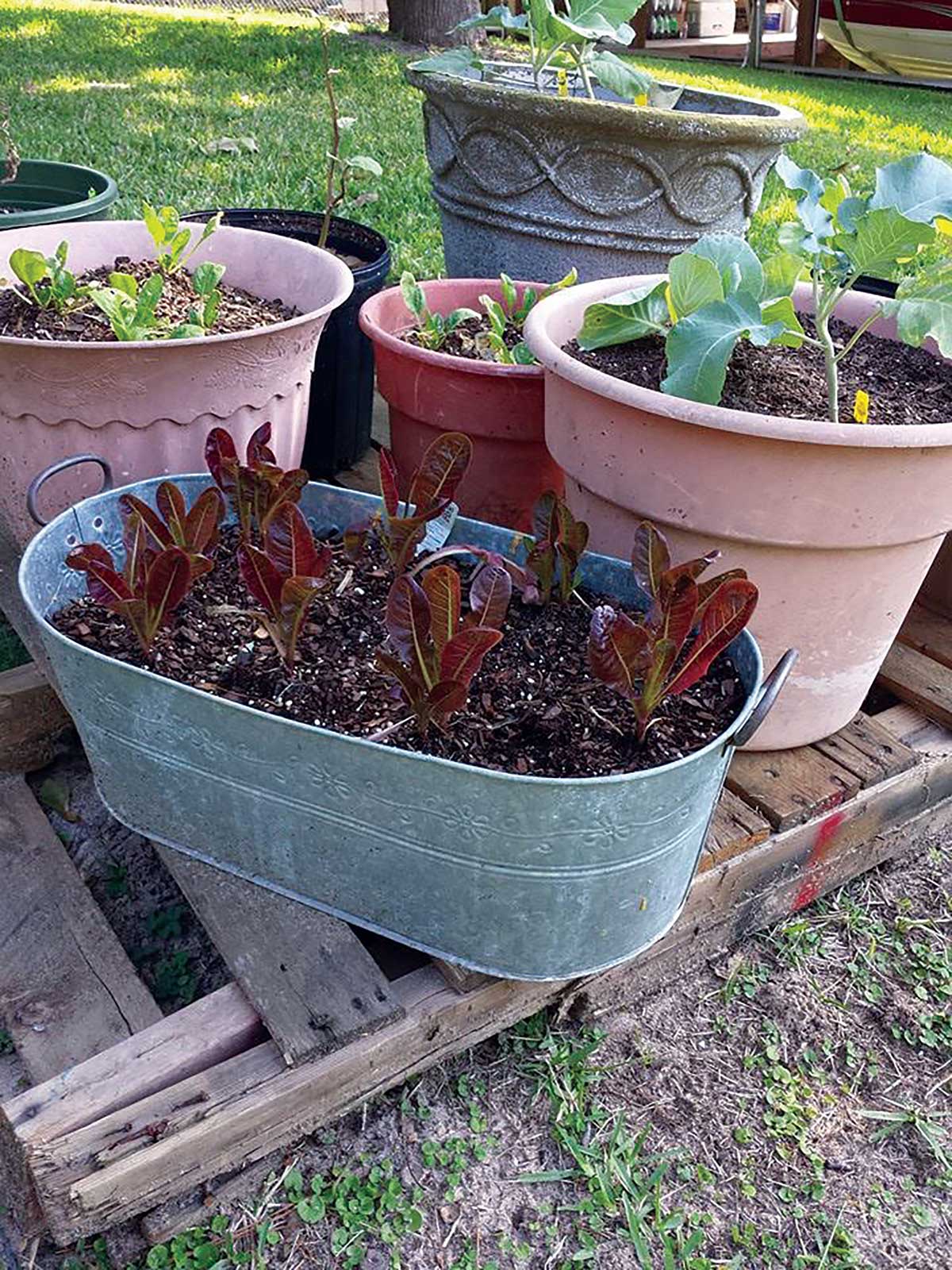
Another simple way to raise your garden is to place containers on a pallet. This keeps away many garden pests and also provides a nice solution for drainage.
Jeff Miller
The No. 1 Rule
Perhaps the best aspect of raised garden beds is the rich, gorgeous soil. That leads us to the No. 1 rule of raised gardening: Do not step on the soil!
The fluffy, light, well-drained soil developed in raised beds is a huge advantage for vigorous plant growth. Stepping on the soil will compact it, and compacted soil reduces aeration, which will slow the activity of valuable microorganisms under the soil’s surface.
Even though you don’t need to put a hard bottom on your raised garden beds in most cases, you can still use weed fabric to prevent weed seeds from germinating in your soil. Weed fabric works in much the same way that cardboard works: It blocks weeds while still allowing for plenty of drainage.
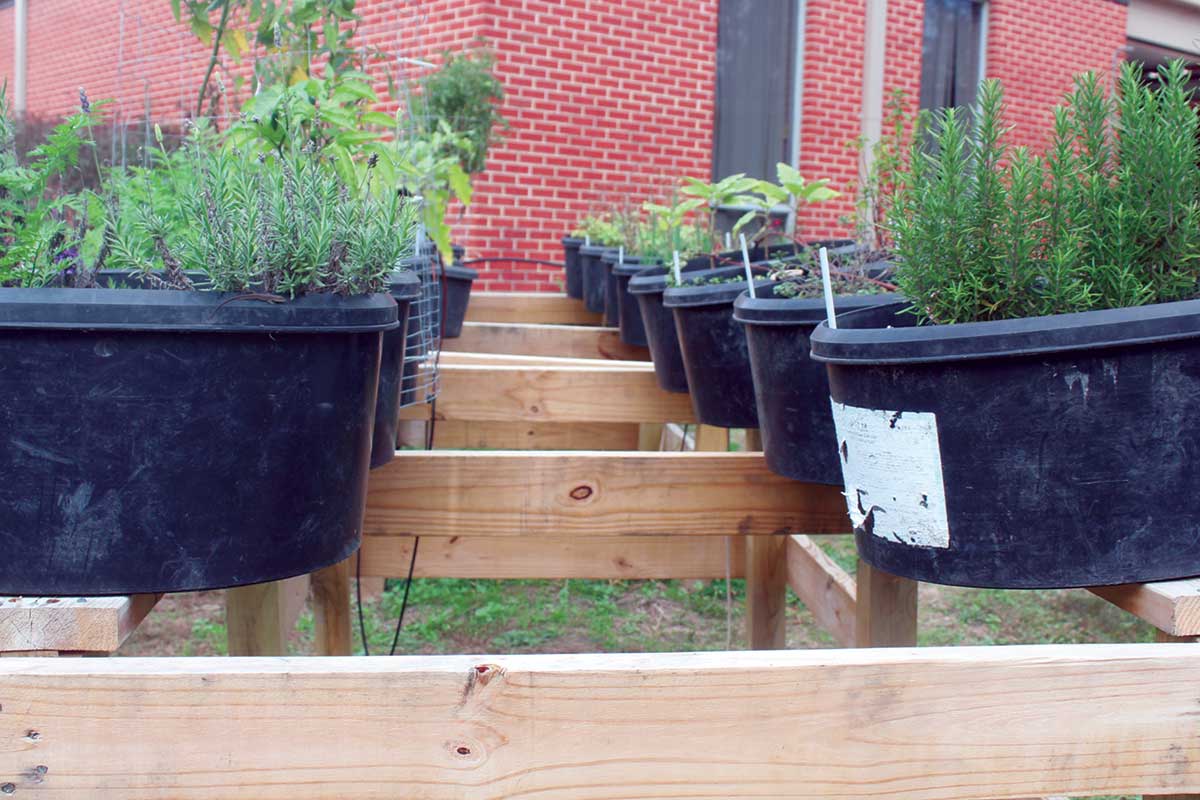
The Texas AgriLife Extension office keeps its tub garden raised on a platform of two-by-fours, which among other benefits requires the gardener to bend over less to care for and harvest the vegetables.
Jeff Miller
Be cautious about the wood used to build your raised bed. Most treated lumber contains toxic chemicals that can leech into the soil, and plants can absorb the chemicals.
In addition to the materials already mentioned, you can create a raised garden bed out of just about anything that will hold soil and plants: a kiddie pool, used tires, scrap wood found on the side of the road, 5-gallon buckets and more. Just keep durability and cost in mind.
Once you get the structure completed, think long and hard about what types of plants you want in the garden. You can mix different fruits and vegetables with flowering plants. There are plenty of good reasons to plant certain crops together:
Deterring pests: Certain plants act as insect repellents or deter critters. For example, garlic’s smell is unappealing to many pests.
Attracting beneficials: Some plants attract beneficial insects. For example, the herb borage is great for attracting pollinating bees and tiny pest-eating wasps.
Shade regulation: Large plants provide shade for smaller plants in need of sun protection. For example, corn shades lettuce.
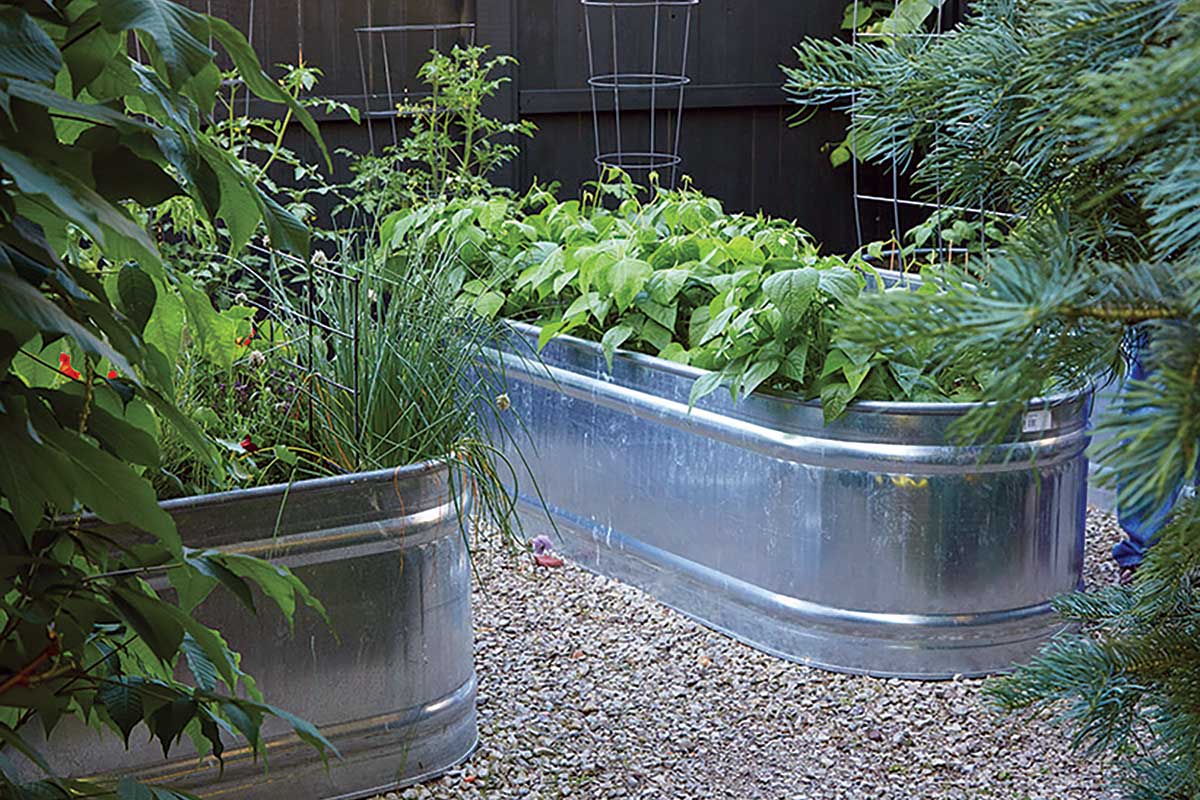
Galvanized tanks can be used as raised garden containers, providing beautiful housing for plants and vegetables. And if needed, they can be moved into a greenhouse in winter.
Jeff Miller
Natural supports: Tall plants, like corn and sunflowers, can support lower-growing, sprawling crops such as cucumbers and peas.
Improved plant health: When one plant absorbs certain substances from the soil, it may change the soil biochemistry in favor of nearby plants.
Enhanced soil fertility: Crops like beans, peas and other legumes help make nitrogen more available in the soil. Similarly, plants with long taproots, like burdock, bring up nutrients from deep in the soil, enriching the topsoil to the benefit of shallow-rooted plants.

A battery-powered watering timer, available at most hardware stores, paired with plastic tubing can provide your plants with regularly scheduled watering, even when you aren’t there.
Jeff Miller
Weed suppression: Planting sprawling crops like potatoes with tall, upright plants minimizes open areas, where weeds typically take hold.
Miller emphasized that raised gardening can not only be a stress reliever, but if you do it right, you can also cut down on those hefty grocery bills.
“Produce prices have been steadily rising ever since the start of the pandemic,” she said. “Raised bed gardening is one fun way to help combat those high prices, and it gives you pride in knowing that you are helping the environment as well.”
